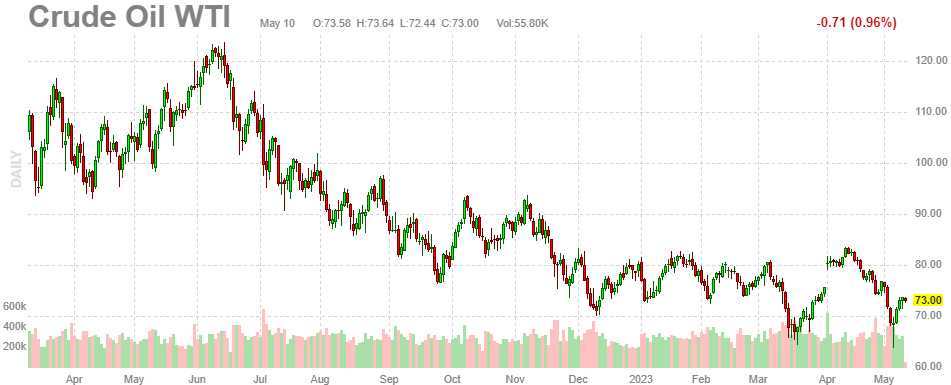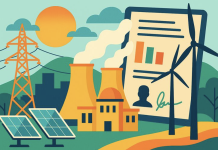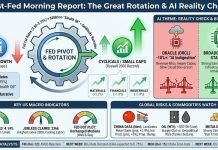 We’re just waiting for the CPI data.
We’re just waiting for the CPI data.
Once we get that (8:30), we can begin speculating on what the Fed will think about it. We already believe April CPI will come in hotter than the 4.8% annualized expected and that’s already 0.4% for April vs 0.1% in March – so not a good trend.
It seemed to me last month prices were climbing back up and Shel-Bot confirmed it twice since then. Updated as of this morning, Shel-Bot says:
⊗Some of the factors that may have influenced the CPI numbers for April are:
-
- Food prices: Food at home increased 8.4% over the year, while food away from home increased 8.8%. Cereals and bakery products rose 13.6%, dairy and related products rose 10.7%, nonalcoholic beverages and beverage materials rose 11.3%, and other food at home rose 11.1%. Fruits and vegetables increased 2.5%, while meats, poultry, fish, and eggs increased 4.3%1
- Energy prices: Energy commodities decreased 17% over the year, mainly due to a sharp drop in gasoline prices (-17.4%). Fuel oil also decreased 14.2%. Energy services increased 9.2% over the year, with electricity rising 10.2% and natural gas (piped) rising 5.5%1
- Shelter prices: Shelter increased 8.2% over the year, with rent of primary residence rising 8.8% and owners’ equivalent rent of residences rising 8%1
- Transportation prices: Transportation services increased 13.9% over the year, with motor vehicle maintenance and repair rising 13.3%, motor vehicle insurance rising 15%, and airline fare rising 17.7%. New vehicles increased 6.1% over the year, while used cars and trucks decreased 11.2%1
- Medical care prices: Medical care commodities increased 3.6% over the year, while medical care services increased 1%. Physicians’ services increased 0.5%, while hospital services increased 2.7%1
- Other prices: Apparel increased 3.3% over the year, alcoholic beverages increased 4.5%, tobacco and smoking products increased 6.9%1
Although Energy prices are down considerably from last year – everything else is going higher and April was, on the whole, more expensive than March – so we’ll see which effect ends up dominating the report.

It may surprise you to know that the wholesale price of Gasoline was $4.20 last May and is not $2.48. If you are not saving $1.70 at your gas station – you should make it a point to ask them why because that’s what they are buying it from the refinery for. Gas prices were about $5 last may at the pump so +0.80 accounts for taxes and profits but if you are paying more than $3.30 now – those are excess profits you are paying!
Speaking of paying – our pal, President Trump was ordered to pay $5M for sexually abusing E. Jean Carroll but it’s only a civil case (like OJ) and he will, of course, appeal until he gets to a judge he appointed – because that’s how the justice system works in America. Trump is still under investigation for various allegations of fraud, tax evasion and obstruction of justice in New York and Georgia and there are 25 other women who have accused the ex-President of various forms of harassment, rape, sexual assault and abuse – but he’s still leading in the GOP polls on the “Family Values” ticket.
 It’s a very important precedent to set that, when you are rich or famous, you have the right to grab girls as you wish. I have two daughters and I wonder how rich or how famous you need to be? Will a local newsman have the right to grope my children or do they have to be national? What about newspaper people or soap opera stars – are they famous enough to rape my daughters with impunity? And how rich? $10M? $1M? $500,000? It would be nice if we all knew where the cut-off is that laws no longer apply to you…
It’s a very important precedent to set that, when you are rich or famous, you have the right to grab girls as you wish. I have two daughters and I wonder how rich or how famous you need to be? Will a local newsman have the right to grope my children or do they have to be national? What about newspaper people or soap opera stars – are they famous enough to rape my daughters with impunity? And how rich? $10M? $1M? $500,000? It would be nice if we all knew where the cut-off is that laws no longer apply to you…
8:30 Update: The CPI came in at 0.4% for the month, the 4.8% pace that was expected. The markets are blasting higher even though no progress means the Fed is far from done. That’s because, TECHNICALLY, last months annual level was 5% and now it’s 4.9% and again, I will point out that’s entirely from a fluctuation in Oil and Gasoline. CORE CPI, which the Fed has said over and over and over again needs to be at 2%, is still at 0.4% for the month.
Average hourly wages rose by 4.4% in April compared to the previous year, slightly faster than the previous month. Hiring remained strong, and the unemployment rate fell to 3.4%, matching its lowest level since 1969. Lindsey Piegza, the chief economist at Stifel Financial, believes that if these trends continue, the Fed may find it difficult to avoid taking further action to address inflation.
 Mostly what is happening now is that the Dollar is being knocked down a quick 0.5%, which provides a 1% boost to the indexes and the indexes are, so far, up less than 1% – so there is nothing impressive going on here at all but it gives the Financial Media Cheerleaders cover to talk about what a great investing environment this is and give trades on the sidelines (us included) as much FOMO as they can.
Mostly what is happening now is that the Dollar is being knocked down a quick 0.5%, which provides a 1% boost to the indexes and the indexes are, so far, up less than 1% – so there is nothing impressive going on here at all but it gives the Financial Media Cheerleaders cover to talk about what a great investing environment this is and give trades on the sidelines (us included) as much FOMO as they can.
 Trading volume so far this week has been under 100M on the SPY for Monday and Tuesday vs 166M last week so a 40% drop in volume so far. That makes it very easy to manipulate the S&P – especially in the very thin pre-market trading. We’ll wait and see what actually sticks.
Trading volume so far this week has been under 100M on the SPY for Monday and Tuesday vs 166M last week so a 40% drop in volume so far. That makes it very easy to manipulate the S&P – especially in the very thin pre-market trading. We’ll wait and see what actually sticks.
Meanwhile, on Monday morning, we asked Shel-Bot to give us 5 companies that were most likely to miss earnings this week and why and he said LCID, ABNB, TTD, HOOD and UBER. Later on, in our Live Member Chat Room, we asked which 5 companies were most likely to beat and Shel-Bot picked PYPL, BNTX, DIS, FVRR and RIVN. LCID, ABNB, PYPL, BNTX and RIVN have reported so far:
- LCID did miss, losing 0.43 vs 0.41 expected and traded lower but no bargain here.
- ABNB beat at 0.18 vs 0.08 expected with 20% revenue growth from last year. The stock popped so wrong call there.
PYPL came in at $1.17 vs $1.10 expected so yes, it was a bet but they guided lower and the stock took a dive. There is more to picking stocks than just whether or not they beat the current earnings – Shel-Bot needs to learn that.
- BNTX had a massive earnings beat at $2.05 vs $0.70 expected – Correct but the stock went lower anyway (good pick-up for us!).
- RIVN also beat as predicted with a $1.25 per share loss but it was better than $1.58 expected and investors were forgiving and patient.
So Shel-Bot is 4 for 5 on earnings picks for the week so far and that means this is a project we will continue to work on. He’s getting better and better at analyzing companies and I’m especially liking our now-famous “The Good, the Bad and the Ugly” reports he’s been producing as it has really helped us focus on what’s happening after the earnings reports are turned in.
For instance, on BNTX, who I think are worth a toss down here. Here’s is Shel-Bot’s report on the earnings:
⊗The Good:
- BioNTech reported strong revenue growth of 7,344% year-over-year, driven by the sales of its COVID-19 vaccine Comirnaty, which it co-developed with Pfizer 1.
- BioNTech reported a net profit of $48 million and a positive EPS of $0.194, demonstrating its ability to generate profitability from its COVID-19 vaccine business 1.
- BioNTech reported a strong cash position of $4.5 billion, which provides sufficient liquidity to fund its operations and growth plans 1.
- BioNTech reiterated its guidance for full-year 2023 COVID-19 vaccine revenue of $15 billion based on current supply contracts 1. The company also said it expects to produce up to three billion doses of Comirnaty in 2023 and has signed contracts for more than two billion doses so far 2.
- BioNTech updated on its pipeline progress and strategic priorities for 2023. The company said it is advancing its next-generation COVID-19 vaccine candidate BNT162b3, which has shown improved immunogenicity and stability in preclinical studies 2. The company also said it is developing combination vaccines for COVID-19 and influenza, as well as COVID-19 and tuberculosis 2. In addition, the company said it is working on key Comirnaty features such as booster shots, pediatric indications, and new formulations 2.
- BioNTech also said it is expanding its oncology portfolio with multiple clinical trials ongoing or planned for its mRNA-based immunotherapies and cell therapies 2. The company said it expects to report data from several trials in the second half of 2023 and initiate new trials for its neoantigen vaccine BNT111 and its CAR-T therapy BNT211 2.
The Bad:
- BioNTech reported a significant decrease in revenue and profitability compared to Q4 2022, reflecting lower demand and pricing for its COVID-19 vaccine as well as higher R&D expenses and taxes 12.
- BioNTech reported an EPS below the consensus estimate of -$0.53 1, indicating that the market expected a larger loss for the quarter.
- BioNTech’s revenue and profitability are highly dependent on the sales of its COVID-19 vaccine Comirnaty, which may fluctuate depending on the demand, supply, pricing, and competition in the market 12.
- BioNTech’s R&D expenses are increasing as it invests in its pipeline development and diversification beyond COVID-19 12.
The Ugly:
- BioNTech’s COVID-19 vaccine business is facing challenges such as new variants, regulatory uncertainties, patent waivers, and emerging competitors 2.
- BioNTech’s COVID-19 vaccine business is also creating opportunities such as new markets, new indications, new formulations, and new combinations 2. However, these opportunities may not materialize or may not be profitable enough to offset the potential decline in Comirnaty sales over time.
Shel-Bot (Bing) is better with facts but Warren (ChatGPT) is better with insights, so I asked him to summarize BNTX’s overall prospects:
♦BioNTech is a biotechnology company that specializes in mRNA-based therapies and vaccines for various diseases, including COVID-19, cancer, infectious diseases, and rare diseases. The company has partnered with Pfizer to develop and commercialize Comirnaty, the first mRNA-based COVID-19 vaccine to receive regulatory approval and emergency authorization in many countries.
Comirnaty has generated significant revenue and profitability for BioNTech, as well as global recognition and reputation. However, as the COVID-19 pandemic evolves and new variants emerge, the demand and pricing for Comirnaty may decline over time, especially as more competitors enter the market and more people get vaccinated. Therefore, BioNTech is investing heavily in its R&D pipeline to diversify its portfolio and create new revenue streams for the future.
The company has more than 20 product candidates in various stages of development, mostly in oncology but also in other areas such as influenza, tuberculosis, multiple sclerosis, and HIV. The company is also advancing its next-generation COVID-19 vaccine candidate BNT162b3, which has shown improved immunogenicity and stability in preclinical studies. The company is also developing combination vaccines for COVID-19 and influenza, as well as COVID-19 and tuberculosis.
In addition, the company is working on key Comirnaty features such as booster shots, pediatric indications, and new formulations. BioNTech’s R&D expenses have increased significantly as it pursues these opportunities, resulting in lower profitability compared to previous quarters.
However, the company has a strong cash position of $4.5 billion, which provides sufficient liquidity to fund its operations and growth plans. The company also reiterated its guidance for full-year 2023 COVID-19 vaccine revenue of $15 billion based on current supply contracts. BioNTech’s outlook is dependent on several factors, such as the evolution of the COVID-19 pandemic and the market dynamics for vaccines, the clinical and regulatory progress of its pipeline candidates, the potential partnerships and collaborations with other companies, and the competitive landscape in its therapeutic areas.
BioNTech has proven its scientific and technological capabilities with Comirnaty, but it still faces many challenges and uncertainties in its quest to become a leading global biotechnology company. BioNTech may be worth the risk as an investment moving forward, but it also requires careful evaluation of its strengths, weaknesses, opportunities, and threats.
In short, the company is a proven R&D operator and $104.68 is a market cap of $25.5Bn and they have $13.8Bn of CASH!!! net of debt. Earnings should be about $1.5Bn for 2023 – despite all the spending – and that makes their market cap less cash less than 10x what they are making. Investors are worried that their Covid money will dry up but I don’t think so because the Flu/Covid combination will keep selling.
Either way, we are left with a cash-rich R&D company who have already proven they can quickly scale up and produce Billions of doses on demand – we just have to wait patiently for the next crisis.
As a new trade, I would play BNTX as follows:
-
- Sell 5 BNTX Dec 2025 $100 puts for $21 ($10,500)
- Buy 10 BNTX Dec 2025 $80 calls for $42 ($42,000)
- Sell 10 BNTX Dec 2025 $130 calls for $22 ($22,000)
That’s net $11,500 on the $50,000 spread so we have $38,500 (334%) upside potential at $120 in about 2.5 years (954 days). We care about the days because, if BNTX goes higher, we may sell some short calls for income like the Sept $115s, which are $6 so 5 of those would fetch $3,000 using 128 of 954 days.
The logic to doing that is we can put a stop at $5,000 and risk $2,000 but the only way we’d stop out is if BNTX made a nice move higher, which benefits our longs. We have 7 opportunities to make sales like that and if only 4 of them are successful we make $12,000 less let’s say $4,000 in losses and that’s net $8,000 – which pays for most of the spread.
From the sale of the puts, we have an obligation to buy 500 shares of BNTX for $100 ($50,000) but, in a Portfolio Margin account, the net margin of the spread is only $2,669.34 – so we’re not tying up a lot of margin to make the trade.
Those are the kind of trades we’ll be looking for when we build our new portfolios but we won’t be ready to do that until “THEY” stop manipulating the market like they are this morning!
Be careful out there…







